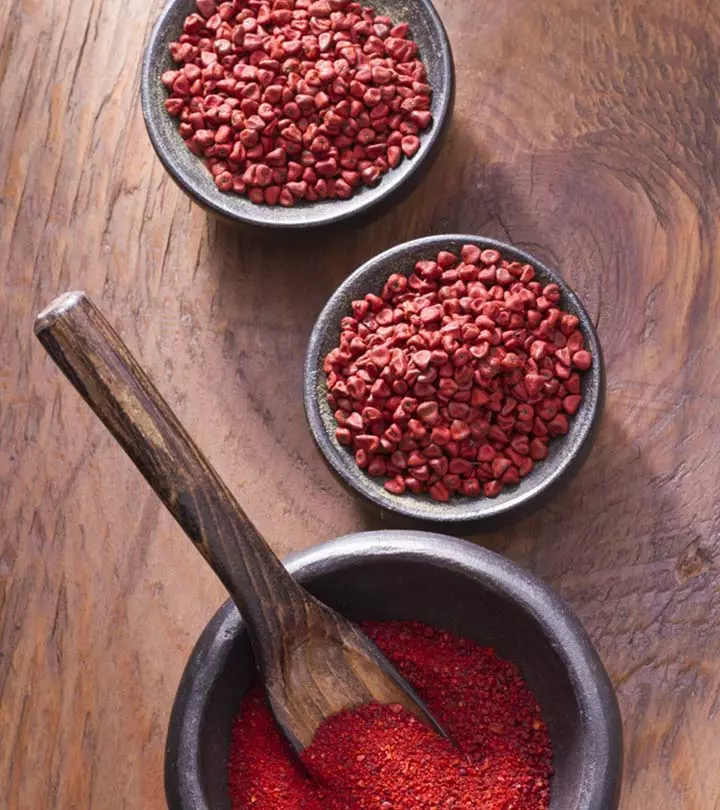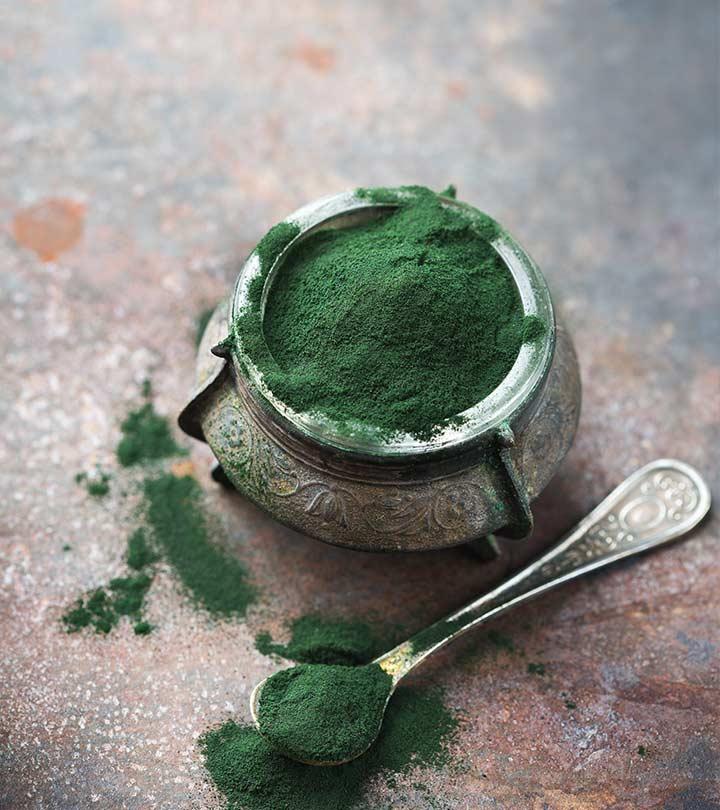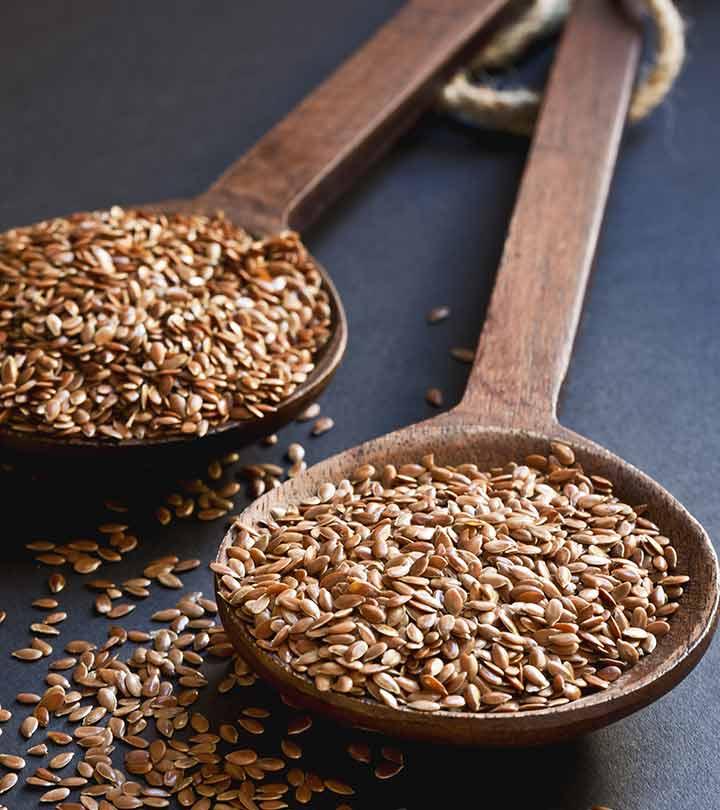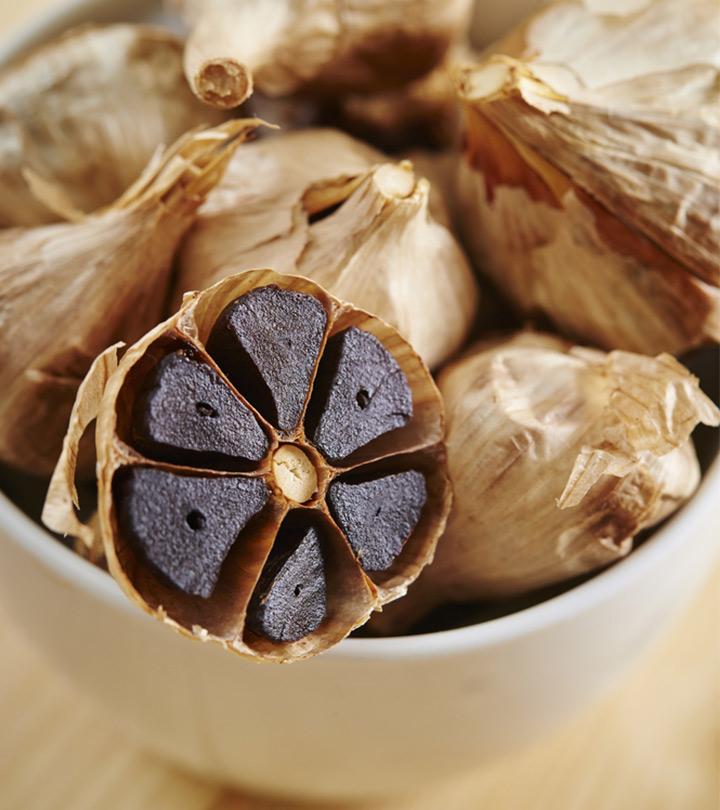Blood Orange: Nutrition Facts, Benefits, And Recipes
This antioxidant-loaded citrus fruit with a uniquely-colored pulp can help you make big health gains.

Image: Shutterstock
Widely known for its unique color among citrus fruits is the blood orange. These delicious oranges have deep reddish flesh due to a polyphenolic compound called anthocyanin. Blood orange nutrition has gained the attention of many health enthusiasts. The fruit is low in calories and high in fiber, vitamin C, and minerals like potassium. Eating blood oranges is said to help lose weight, boost immunity, and reduce the risk of chronic diseases like cancer and diabetes. But what does science say? In this article, we explore the health benefits of blood orange, their types, and a few simple recipes to try. Keep reading.
 Know Your Ingredient: Blood Orange
Know Your Ingredient: Blood OrangeWhat Is It?
A variety of orange of southern Mediterranean origin, characterized by its brilliant reddish-hued flesh.
What Are Its Benefits?
May prevent fat accumulation, boost immunity, prevent cancer, help blood glucose management, and protect the skin from UV ray damage.
Who Can Consume It?
Can be safely consumed by people of all age groups including pregnant women.
How Often?
Ideally, one fruit can be consumed daily.
Caution
Overconsumption may cause digestive problems due to excess fiber content in these fruits.
In This Article
What Is Blood Orange?
Blood orange (red orange) is a citrus fruit that originated in the Southern Mediterranean region in the 18th century. These oranges (scientifically called Citrus sinensis) are a natural mutation of pomelo-tangerine hybrids and are smaller than other types of oranges.
Blood orange trees grow best in warm, temperate climates (from December to April). These oranges are easy to peel, have fewer seeds, and taste sweeter than raspberry oranges. You can eat them raw or prepare their juice or add them to baked goods, cocktails, salads, or other dishes that call for oranges.
 Trivia
TriviaBlood oranges are available in many varieties, and each variant is known for its unique taste, texture, and nutritional value. Continue reading to explore the types of blood oranges.
Varieties Of Blood Orange
The three main types of blood oranges include Tarocco, Sanguinello, and Moro while the less common ones are Maltese, Khanpur, Washington Sanguine, Ruby Blood, Sanguina Doble Fina, and Delfino.
- Moro
Moro is the most vibrant blood orange, with a deep red flesh and bright red rind. It is described as a “deep blood orange”, whose flesh ranges from orange-veined ruby to vermillion, deep crimson, and to nearly black. These oranges are milder in flavor and have a strong aroma. Moro has a more bitter taste than Tarocco or Sanguinello and is said to have originated around Lentini in the 19th century.
- Tarocco

It is called “the half-blood” variety as the red pigmentation on the flesh is visible. It is less popular than the other two varieties and is grown mostly around Mount Etna. Tarocco oranges are sweet and juicy and have the highest vitamin C concentration. Also, they have thin orange skin blushed with red and contain no seeds.
 Fun Fact
Fun Fact- Sanguinello
Sanguinello (also called Sanguinelli in the US) is a type discovered in Spain in 1929. It has fewer seeds, and its flesh is sweet and tender. The fruit matures in winter but remains on trees until April if grown in the Northern Hemisphere. It may continue to ripen until the end of May. Its yellow skin is compact and has a clear color with a red tint while the flesh is orange with multiple red streaks.
All these types contain fewer calories but are rich in fiber, vitamins, minerals, and antioxidants. Here is a breakdown of the nutritional profile of blood oranges.
Nutrition Facts Of Blood Orange
A serving (100 grams) of blood orange contains (1):
| Calories | 45 kcal |
| Protein | 0.65g |
| Carbohydrate | 9.74g |
| Fiber | 1.9g |
| Fat | 0.42g |
| Calcium | 26 mg |
| Iron, Fe | 0.19 mg |
| Potassium, K | 169 mg |
| Sodium | 0 mg |
| Vitamin C | 52.3 mg |
| Cholesterol | 0 mg |
Consuming nutrient-rich blood oranges is associated with many health benefits. Let us discover the many blood orange benefits in the following section.
Health Benefits Of Blood Orange
1. May Inhibit Fat Accumulation
Blood oranges may help with weight loss as they are low in calories and high in fiber. They also have anti-adipogenic and antioxidant properties (2). The intake of Moro juice for 12 weeks was found to reduce weight gain and fat accumulation in mice. This was regardless of an increase in energy levels due to its high sugar content. These mice were also resistant to high-fat-diet-induced obesity. Studies suggest that multiple components, including anthocyanin, in the Moro juice may be responsible for these beneficial effects (3).
2. May Boost Immunity

Blood orange contains a significant amount of vitamin C, which has immunostimulant properties. This vitamin helps prevent cell damage by reducing oxidative stress and inflammation (4). Besides, vitamin C supplementation was found to improve white blood cell production and boost killer cell activities. These functions help strengthen the immune system (5).
According to a study, micronutrients (like vitamin C and folate) and other bioactive compounds in citrus fruit juices have established roles in supporting immune responses (6).
3. May Reduce The Risk Of Cancer
Holly Klamer, MS, RDN, says, “Blood oranges are a good source of antioxidants, including vitamin C and anthocyanins. Antioxidants work to protect cells from damage from carcinogens, UV rays, pollutants, and other harmful substances.”
Caffeic acid, ferulic acid, anthocyanins, and chrysanthemins found in blood oranges also demonstrate strong antioxidant and cancer-protective effects. Besides, these oranges were also shown to be cytoprotective (protecting the cells from harmful agents). These properties, in turn, may help reduce the risk of chronic diseases like cancer (7).
4. May Reduce The Risk Of CVD
A study showed that drinking 500 ml of commercial red orange juice reduced total and LDL cholesterol levels (8). Besides, supplementing vitamin C (500 mg/d)for four weeks was shown to decrease LDL and triglyceride levels (9). This way, the improved lipid profile may help reduce cardiovascular disease (CVD) risk. A study also found that dietary vitamin C intake is linked with a reduced risk of stroke (10).
High potassium content in blood oranges may also help manage high blood pressure, which is a major cause of CVD, stroke, and coronary heart disease (7).
5. May Reduce The Risk Of Diabetes

Flavonoids are the main bioactive compounds in citrus fruits. They have multiple beneficial effects. They also have anti-diabetic properties. They regulate biomarkers associated with glycemic control, lipid profiles, renal function, hepatic enzymes, and antioxidant enzymes. Moreover, citrus flavonoids also modulate signaling pathways related to glucose uptake and insulin sensitivity (11). Hence, these flavonoids are considered promising anti-diabetic candidates.
6. May Promote Skin Health
Citrus fruits, like oranges, play a key role in maintaining skin health. In a study, intake of a red orange extract was found to increase antioxidant skin defenses and prevent photodamage. As stated, blood oranges are also rich in vitamin C, which provides antioxidant protection against UV-induced photodamage (12). Moreover, oranges contain beta-cryptoxanthin, which gets converted into vitamin A in the body. This vitamin is known for its anti-wrinkle and anti-aging effects (13).
Pair blood oranges with healthy eating to reap their benefits. We have listed three simple blood orange recipes in the following section. Keep reading.
Blood Orange Recipes

1. Blood Orange Salad
What You Need
- Blood oranges: 2
- Extra virgin olive oil: ¼ cup
- White wine vinegar: 2 tablespoons
- Honey: 2 teaspoons
- Kosher salt: ¾ teaspoon
- Black pepper: ¾ teaspoon
- Fennel bulb: 1 small (cored and thinly sliced)
- Chopped toasted hazelnuts: ⅓cup
- Torn fresh mint: ¼ cup
- Curly endive leaves: ¼ cup
- Radicchio: ¼ cup (chopped)
- Shallot: 1 small (thinly sliced)
- Hazelnuts: ¼ cup
Method
- Peel the oranges and slice them. Use some slices to make juice (3 tablespoons).
- Mix the oil (2 tablespoons), vinegar, blood orange juice, honey, salt, and pepper in a bowl.
- Prepare a platter with orange slices, endive, radicchio, and fennel. Sprinkle hazelnuts, mint, and shallots over the top.
- Pour the juice mixture over the top and serve.
2. Blood Orange Cake
What You Need
For Blood Orange Puree
- Medium blood oranges: 3(sliced into ¼” rounds)
- Water: 2 cups
For cake
- Blood orange puree: 2 cups
- Butter (melted): ½ cup
- Egg: 1 (lightly beaten)
- All-purpose flour: 1½ cups
- Granulated sugar: 1 cup
- Baking powder: 1 tablespoon
- Salt: ½ tablespoon
For glaze
- Blood orange juice: 250 ml
- Confectioner’s sugar: 1 cup
Method
- Bring the blood orange slices and water to a boil in a medium saucepan.
- Cover and simmer for 20 minutes once boiled.
- Let cool for 10 minutes and blend on high power until it is completely smooth.
- Preheat the oven. Line a round cake pan with parchment paper by greasing and flouring it.
- Mix two cups of blood orange puree, melted butter, and egg in a large bowl. Separately, whisk flour, sugar, baking powder, and salt.
- Mix the orange mixture well with the flour. Gently fold well with a rubber spatula.
- Bake in the center of the oven for about 40 minutes. Allow it to cool in the pan for a few minutes.
- Prepare the glaze by mixing the juice and confectioner’s sugar until smooth. Drizzle the glaze over the cake once it is entirely cooled.
Julia and Lauren, sisters and bloggers, shared their experience of making a blood orange olive oil upside-down cake. Lauren wrote, “The hardest part of this bake is that you have to wait at least 24 hours before you can eat it. Okay, HAVE TO is a strong statement, but it was encouraged so that’s what I did. And I think it was worth the wait; this cake tasted better with each day it sat out. It tasted so light and rich—it was a winner for me (i).”
3. Blood Orange Chicken

What You Need
- Skinless, boneless chicken breast halves: 4
- Blood oranges: 2 (to squeeze over chicken)
- Blood oranges: 3 (juiced)
- Olive oil: 3 tablespoons
- Butter: 1 tablespoon
- Onion: ½ (minced)
- Garlic cloves: 3 (chopped)Chicken stock: ¾ cup
- Dry white wine: 3 tablespoons
- Fresh parsley: 1 teaspoon (chopped)
- Honey: 1 tablespoon
- Salt (to taste)
- Freshly ground black pepper (to taste)
Method
- Squeeze the juice of two blood oranges over the chicken pieces in a baking dish. Let it marinate for up to 24 hours.
- Heat the olive oil in a large skillet over medium flame.
- Season each piece of chicken with salt and black pepper, and fry on both sides.
- Melt butter in a clean skillet over medium flame, and fry onion and garlic until they turn brown.
- Add the blood orange juice, chicken stock, white wine, and parsley, and bring to a boil.
- Reduce heat to low and return chicken slices to the skillet.
- Transfer the chicken pieces alone to serving plates.
- Dissolve the honey in the juices and simmer the sauce until it thickens (about 2 minutes).
- Spoon the sauce over the chicken portions to garnish.
The delicious taste of these sweet and savory dishes can only be enjoyed if cooked with fresh blood oranges. However, getting fresh blood oranges may not be easy all the time. But storing them right can keep them fresh for long. Here are a few tips.
How To Store Blood Oranges
- Whole Blood Oranges
Refrigerate or leave them on the counter (which is clean and dry) for a few days. Wrap them in a paper towel if you are refrigerating them.
- Cut halves
Cover with plastic wrap and refrigerate for a week.
- Segments
Refrigerate for four days in an airtight bag or container.
- Zest
Spread the zest out on a tray to quickly freeze it. Transfer it to a sealed container once frozen and freeze for three months.
- Juice
Refrigerate for three days in a sealed container. Freezing works best if you use ice cube trays and store them in airtight containers.
Blood oranges are delicious and provide a wide range of health benefits. However, it is important to learn about their potential side effects before consuming them. Learn about them in the next section.
Side Effects Of Blood Orange
- May Increase The Risk Of Kidney Stones
Blood oranges are rich in vitamin C, whose excess may elevate uric acid and oxalate levels. This may increase the risk of developing kidney stones and diseases (1), (14). - May Cause An Allergic Reaction
Some individuals may be allergic to blood oranges, leading to symptoms such as itching, swelling, nausea, vomiting, or hives (14). - May Erode The Enamel
The rich vitamin C content in blood oranges, whose excess and prolonged consumption may dissolve the outer layers of your teeth and damage the enamel (1), (15).
Infographic: Top 5 Benefits Of Adding Blood Oranges To Your Diet
Blood oranges offer a range of health benefits that make it the perfect addition to your diet plan. From fresh fruit salads and juices to tangy sorbets and zesty marinades, this fruit can elevate both sweet and savory recipes. Check the infographic below for the top 5 benefits of adding blood oranges to the diet.

Illustration: StyleCraze Design Team
Blood oranges are known for their unique color and taste. They are gaining the attention of many health enthusiasts because of their high vitamin C content and many other beneficial nutrients. Blood oranges are nutrient-dense, and if included in your diet, blood oranges can inhibit fat accumulation, boost immunity, reduce cancer risk, reduce the risk of cardiovascular diseases, promote skin health, and cut down the risk of diabetes. We hope the blood orange fruit nutrition facts discussed in the article gave you an idea about the health benefits of this citrus fruit. Try any of the recipes mentioned above to enjoy blood oranges.
Frequently Asked Questions
Is blood orange a superfood?
Yes. Blood oranges are a powerhouse of nutrition. They contain antioxidants, fiber, and potassium and help improve your health in many ways.
Is blood orange good for hair?
Yes. The presence of antioxidants in blood oranges may help fight against free radicals, preventing hair follicle damage and promoting hair growth.
Is blood orange grapefruit?
No. Both are different fruits. Blood oranges are a type of orange, while grapefruit is a hybrid of pomelo and oranges.
Key Takeaways
- Blood oranges are low-calorie citrus fruits that are high in vitamin C, fiber, and minerals.
- They help boost your immunity and play a role in preventing chronic health conditions.
- You can include blood oranges in salads, cakes, savory meat dishes, and other interesting ways.
Illustration: Blood Orange: Nutrition Facts Benefits And Recipes

Image: Stable Diffusion/StyleCraze Design Team
Blood oranges are a unique citrus fruit with a deep red flesh and sweet-tart flavor. Learn about their health benefits and how to enjoy them from this video!
Personal Experience: Source
StyleCraze's articles are interwoven with authentic personal narratives that provide depth and resonance to our content. Below are the sources of the personal accounts referenced in this article.
i. Blood Orange Olive Oil Upside Down Cakehttps://sistersandsaffitz.wordpress.com/tag/cakes-claire-saffitz-dessert-dessert-person-fruit-oranges-blood-oranges-upside-down-cake-olive-oil-olive-oil-cake/
References
Articles on StyleCraze are backed by verified information from peer-reviewed and academic research papers, reputed organizations, research institutions, and medical associations to ensure accuracy and relevance. Read our editorial policy to learn more.
- Blood Orange
https://fdc.nal.usda.gov/fdc-app.html#/food-details/1745219/nutrients - Anti-adipogenic and anti-oxidant effects of a standardised extract of Moro blood oranges ( Citrussinensis (L.) Osbeck) during adipocyte differentiation of 3T3-L1 preadipocytes
https://pubmed.ncbi.nlm.nih.gov/34414846/ - Blood orange juice inhibits fat accumulation in mice
https://www.researchgate.net/publication/40759870_Blood_orange_juice_inhibits_fat_accumulation_in_mice - Ascorbic acid: its role in immune system and chronic inflammation diseases
https://pubmed.ncbi.nlm.nih.gov/24766384/ - Immune-enhancing role of vitamin C and zinc and effect on clinical conditions
https://pubmed.ncbi.nlm.nih.gov/16373990/ - Effects of Citrus Fruit Juices and Their Bioactive Components on Inflammation and Immunity: A Narrative Review
https://www.ncbi.nlm.nih.gov/pmc/articles/PMC8264544/ - Effect of increased potassium intake on cardiovascular risk factors and disease: systematic review and meta-analyses
https://pubmed.ncbi.nlm.nih.gov/23558164/ - Effect of Red Orange Juice Consumption on Body Composition and Nutritional Status in Overweight/Obese Female: A Pilot Study
https://www.ncbi.nlm.nih.gov/labs/pmc/articles/PMC5376946/ - Vitamin C supplementation lowers serum low-density lipoprotein cholesterol and triglycerides: a meta-analysis of 13 randomized controlled trials
https://www.ncbi.nlm.nih.gov/labs/pmc/articles/PMC2682928/ - Vitamin C Intake Circulating Vitamin C and Risk of Stroke: A Meta‐Analysis of Prospective Studies
https://www.ncbi.nlm.nih.gov/labs/pmc/articles/PMC3886767/ - Citrus Flavonoids as Promising Phytochemicals Targeting Diabetes and Related Complications: A Systematic Review of In Vitro and In Vivo Studies
https://www.ncbi.nlm.nih.gov/labs/pmc/articles/PMC7598193/ - The Roles of Vitamin C in Skin Health
https://www.ncbi.nlm.nih.gov/pmc/articles/PMC5579659/ - Retinoids: active molecules influencing skin structure formation in cosmetic and dermatological treatments
https://www.ncbi.nlm.nih.gov/labs/pmc/articles/PMC6791161/ - Vitamin C (Ascorbic Acid)
https://www.ncbi.nlm.nih.gov/books/NBK499877/ - Dental erosion from an excess of vitamin C
https://pubmed.ncbi.nlm.nih.gov/34559686/
Read full bio of Dr. Pallavi Srivastava
Read full bio of Ravi Teja Tadimalla
Read full bio of Sindhu Koganti


























Community Experiences
Join the conversation and become a part of our empowering community! Share your stories, experiences, and insights to connect with other beauty, lifestyle, and health enthusiasts.